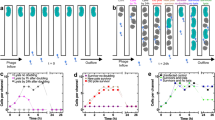Abstract
Bacteriophage (phage) are ubiquitous in the water column and in the sediments of most natural water. Because of their colloidal nature, they can either aggregate into clumps large enough to settle into the sediment or departing upon the physiochemical conditions or disassociate and reenter the water column. About 80% of the bacterial strains isolated from New River sediment have a virulent phage that can be isolated with them.
Liquid cultures of a strain of Pseudomonas aeruginosa isolated from the New River along with its phage were set up. One was infected with the virulent phage and another kept as a control. Daily counts were made of bacterial numbers. After 10 days the control culture was infected and counted for 3 more days.
Both cultures divided exponentially at first. The infected culture continued to divide at about half the initial rate. The uninfected culture nearly ceased division, but when phage were added it quickly began to divide.
The virulent phage infection clearly stimulated host division. The effect was to establish itself as an endemic infection which did not outpace its host's division rate. Further, the enhanced division rate may act to increase the host's share of available nutrients and benefit its competitive position in the system.
Similar content being viewed by others
References
Gerba, C. P. & G. E. Schailberger, 1975. Effect of particulates on virus survival in sea water. J. Wat. Pollut. Cont. Fed. 47: 93–103.
Gerba, C. P., S. R. Farrah, S. M. Goyal, C. Wallis & J. L. Melnick, 1978. Concentration of enterovirus from large volumes of tap water, treated sewage, and sea water. Appl. envir. Microbiol. 35: 540–548.
Lammers, W. T., 1971. Insoluble material in natural water: Water and Water Pollution Handbook. L. L. Ciaccio (ed.), Marcel Dekker, New York: 593–638.
Lammers, W. T., 1988. Yearly flux of virus-like particles and humic acid in river sediment. Verh. int. Ver. Limnol. 23: 1219–1223.
Lammers, W. T., 1990. Bacterial hosts of bacteriophage isolated from river water. Verh. int. Ver. Limnol. 24: (in press).
Laboratory Methods of the U.S. Army, 1944. U.S. Govt. Print. Office, Washington, 404 pp.
Phillips, D. S., 1978. Basic Statistics for Health Science Students. Freeman, New York, 185 pp.
Zobell, C. E., 1946. Marine Microbiology. Chronica Botanica. 240 pp.
Author information
Authors and Affiliations
Rights and permissions
About this article
Cite this article
Tuthill Lammers, W. Stimulation of bacterial cytokinesis by bacteriophage predation. Hydrobiologia 235, 261–265 (1992). https://doi.org/10.1007/BF00026218
Issue Date:
DOI: https://doi.org/10.1007/BF00026218




